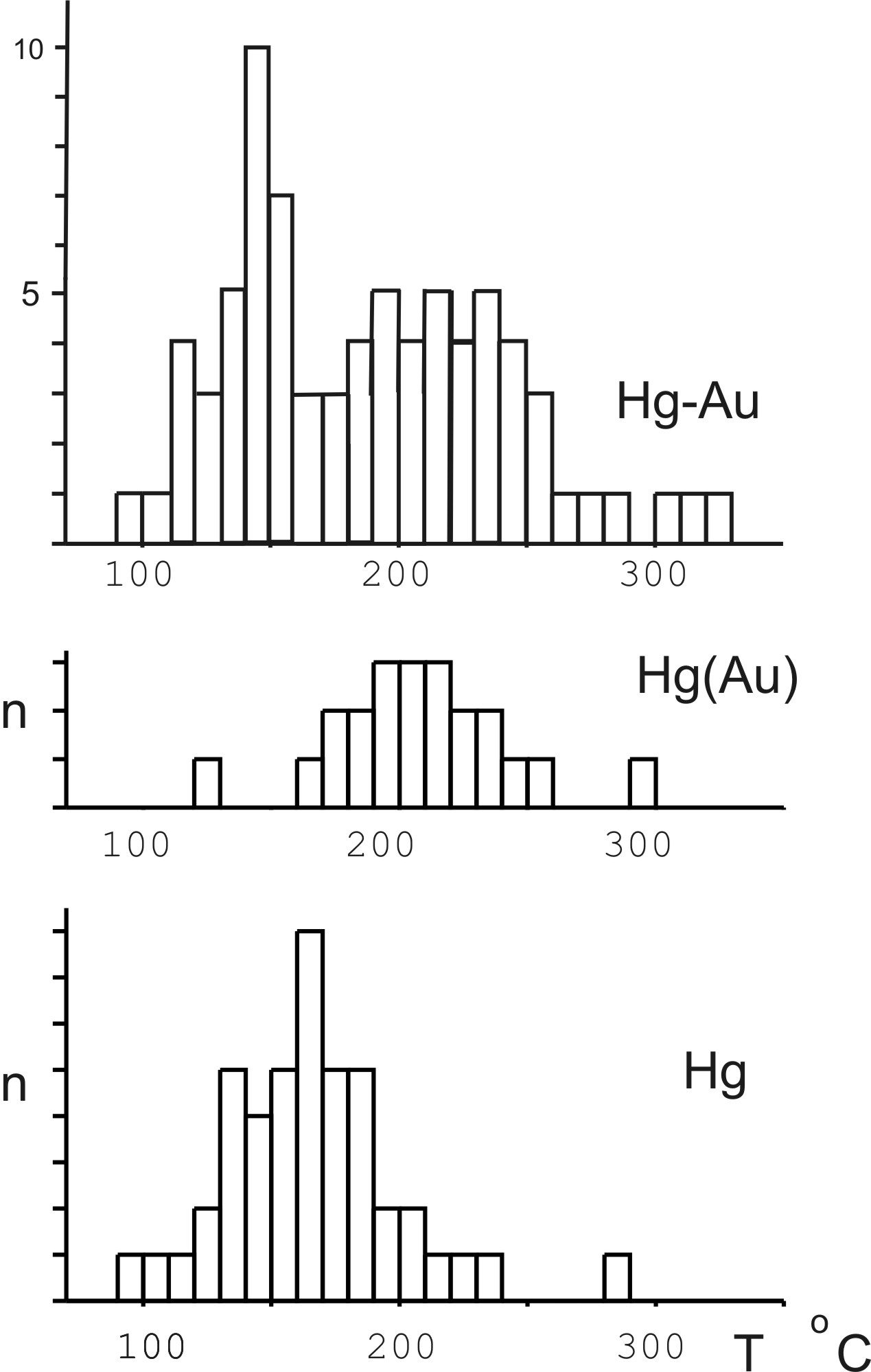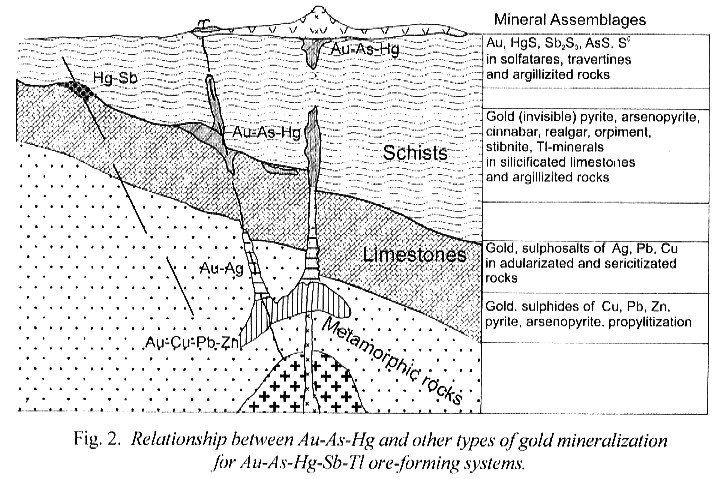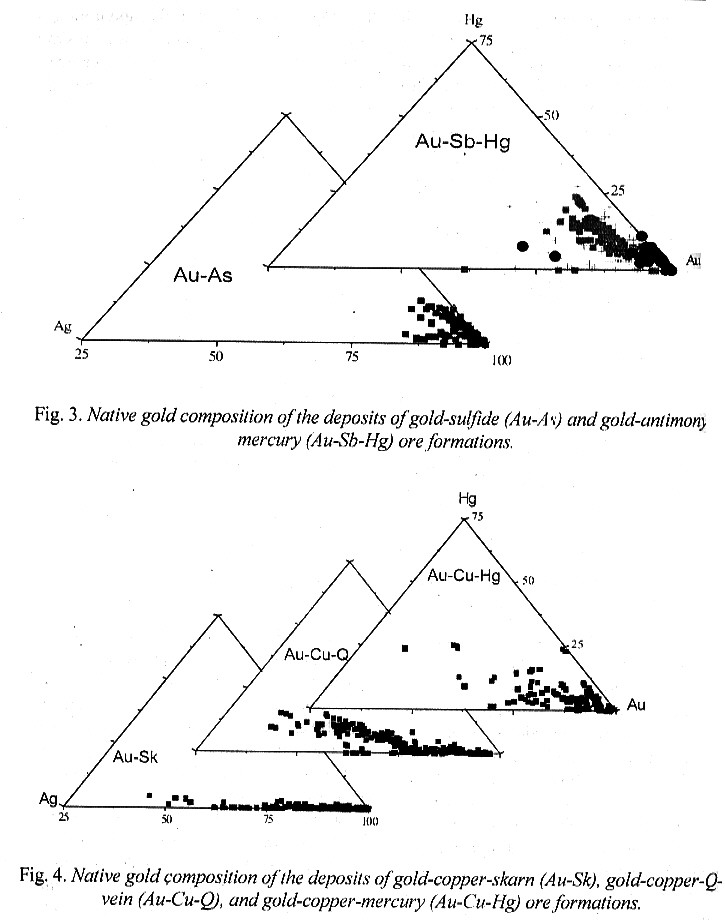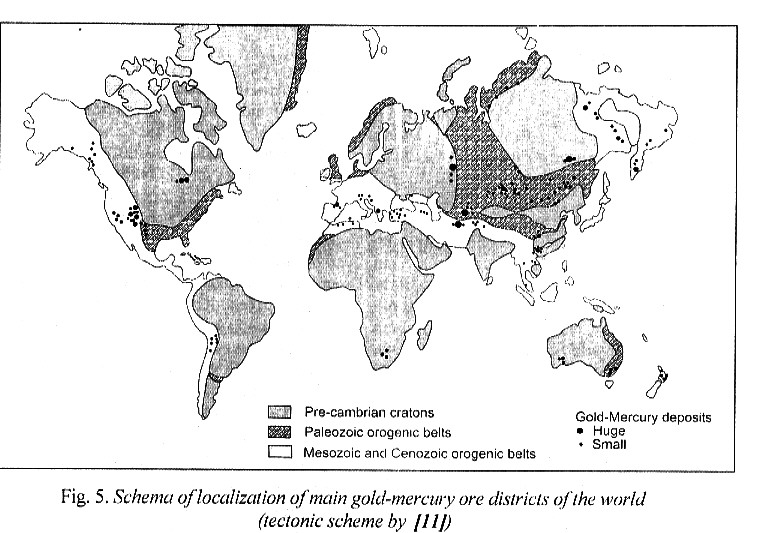GOLD-MERCURY
DEPOSITS OF THE
A.S. BORISENKO,
E.A. NAUMOV, G.G. PAVLOVA, M.V. ZADOROZHNY
Abstract: The gold-mercury
mineralization represents one of new promising type of gold deposits. Four ore-formational
types are distinguished: Au-As-Hg, Au-Sb-Hg, Au-Te-Hg and Au-Cu-Hg, which are genetically
related to various types of gold mineralization and produced by different ore-forming
systems. In the East and
I. INTRODUCTION
Gold-mercury type is one of the new perspective, but
unusual type of deposits in a number of ore provinces of the world. Numerous publications
summarize the data on Au-Hg deposits [ 1, 6, 8, 9,
19-21, etc ]. Major deposits of such type are hosted in a number of gold provinces
of the world and successfully exploited: Carlin, Cortez, Bell (Nevada); Knoxwille,
New-Idria (California), Hemlo (Canada); Dongbaishan, Lianchecum, Zimudang (China);
Alsar (Macedonia); Zarshuran (Iran); Vorontsovskoe (Ural); Kuchus, Galkhaya, Svetloe
(Yakutia); Tas-Yuryakh (Khabarovsk region); Konchoch, Djalama (Middle Asia); Murzinskoe
(Altai); Soloneshnoye, Nerchinskoye in East Transbaikalia; Unegen-Del in Mongolia
and Semeitaus ore district in Kazakhstan.
II. TYPES OF Au-Hg DEPOSITS
Epithermal Au-Hg deposits in recent classifications
are distinguished as gold deposits of Nevadian or Carlin-type. Deposits with gold-antimony-mercury,
gold-sulfide, gold-arsenic and "invisible gold" mineralization are applied
to three class of volcanic-hydrothermal, telethermal or hydrothermal-sedimentary
deposits. The uncertainty of formational type is explained by their polygenetic
nature and convergency of features, due to which the deposits are united into one
group.
There are different viewpoints on the genesis of Au-Hg
mineralization.
1. Superimposition of Sb-Hg ore on the earlier gold
mineralization.

Fig. 1. Temperature
of forming ores from Au-Hg and Hg deposits determined by fluid inclusion data (using
published data and Naumov et al., 2002)
2. Au-Hg deposits are the typical Sb-Hg deposits,
where gold appears by borrowing from wall rocks.
3. Au-Hg deposits are typical high-medium temperature
gold objects, where Ag, Sb, and Hg mineral associations are prevalent in the final
low temperature stages of hydrothermal process.
4. Au-Hg deposits are low temperature hydrothermal
objects, which are formed on high, subsurface level of ore-magmatic systems of different
types (authors’ data).
In spite of different ideas about genesis, these deposits
are characterized by similar features, allowing to unite
them in one group:
1) Singularity of chemical composition of the ore:
Au, Ag, Hg, Sb, As (major), Tl, Te, Ba, Cu, Pb, Zn ± Mo, W (minor), Rb, Cs, V, Co (rare);
2) Similarity of mineral composition: invisible gold
(often Hg-bearing), As-pyrite, arsenopyrite (crystals of niddle-like and elongated-prismatic
shape), Hg minerals (cinnabar, Hg-sphalerite, Hg-tetrahedrite, coloradoite, etc.),
stibnite, realgar, orpigment, Tl minerals, carbonates, barite, chalcedony-like quartz,
clay minerals, etc.;
3) Low temperature of the ore formation 300-50°C
(common range of 200-50°C ) (Fig. 1);
4) Low temperature of metasomatic processes of alteration
of host rocks – argillization of alumosilicate rocks, silicification of limestones
and listvenitization of basic and ultrabasic rocks;
5) Structure of ore bodies, represented by ore metasomatites
with weak development or absence of vein component.
Moreover, in spite of striking similarity of mineral
composition (gold, As-pyrite, arsenopyrite, cinnabar, stibnite, realgar, sulfosalts,
barite), geochemical features of the ores (Au, Ag, As, Sb, Hg, Tl, Ba ± Mo, W) and metasomatic wall rock alteration
(argillite, berezite, jasperoid), Au-Hg deposits occur in different geodynamic settings.
They are associated with various volcanic, intrusive and ore complexes, and are
derivatives of different types of ore-magmatic systems. Analysis of the forming
conditions of these deposits and mineral-geochemical features of the ore, correlation
with magmatism and the other types of the ore allows to distinguish sufficiently
reliable four genetic rows, the composition of which includes corresponding ore
formations of Au-Hg deposits [3] (Table 1).
1) gold-sulfide (Au-Pb-Zn) ® gold-silver (Au-Ag) ® gold-arsenic-mercury (Au-As-Hg) ®
mercury (Hg-Sb);
2) gold-sulfide (Au-As) ® gold-antimony-mercury (Au-Sb-Hg) ® mercury (Hg-Sb);
3) Cu-Mo (Au)-porphyry (Cu-Mo-Au) ® gold-silver-tellurium (Au-Ag-Te) ® gold-tellurium-mercury (Au-Te-Hg) ® mercury (Hg-Sb);
4) gold-copper-skarn (Au-Cu-Sk) ® gold-copper-quartz-vein (Au-Cu-Q) ® gold-copper-mercury (Au-Cu-Hg) ® mercury (Hg-Sb).
Deposits of gold-arsenic-mercury ore formation are
common for regions of development of volcanic-related hydrothermal Au-Pb-Zn, Au-Ag
and Sb-Hg mineralization under the intraplate rifting condition, in space and time
associated with basalt-andesite-rhyolite (Carlin, Cortez, Bell in Nevada, Kaletash,
Akoluk, Mastra in Turkey) or trachybasalt-trachydacite-trachyrhyolite (Alsar in
Macedonia, Semeitausky ore district in East Kazakhstan) volcanism. Classic district
with mineralization of such type is Nevada gold region in USA, where Au-Ag and Sb-Hg,
and Au-As-Hg mineralization (the last is recognized by American geologists as Carlin
type) formed in the association with Cenozoic magmatism during 3 main periods starting
from Eocene (43-36; 26-22; 9-5 Ma) [4, 23].

The most productive phase was the Eocene 43-32 Ma
epoch, during of which large deposits formed, such as Carlin, Cortez, Getchell,
Betze with common resources of more than 2500 t of Au.
Typical position of localization of various types of mineralization in this region
is shown on
Gold mineralization in the regions (ore knots)
with deposits of such formational type are formed on three levels: surface level
travertines and lake sediments of hot springs Waiotapy, Broadlands, Rotokawa in
New Zeland, Steamboat Springs in Nevada, El Tatio in Chile, Senator in Turkey);
subsurface level (mineralized zones and layer-like bodies of Carlin, Cortez, Getchell,
Betze deposits in Nevada; Knoxwille, New-Idria in California, Alsar in Makedonia;
Kaletash and Akoluk in Turkey and other), and middle-depth level (Au-Ag deposits
in Nevada, Mastra and Olakek in Turkey). In a number of ore districts mineralization
of different levels extends over vertical interval from the deep level up to the
surface.
Deposits of gold-antimony-mercury ore formation are
known out of regions of development of volcanic activity, but are close to the intrusive
complexes of calc-alkaline and K-calc-alkaline series. The ores are spatially and
temporarily connected to plutonic-related hydrothermal gold-sulfide (gold-arsenopyrite
type), Sb-Hg, and possibly Au-Sb mineralization, that is in concordance with similarity
of geological situations, closeness of age, similarity of mineral composition, including
composition of native gold (Fig. 3) and geochemical features. Typical regions of
localization of these ores are
The ore of Au-Sb-Hg and Au-As-Hg deposits is characterized
by Au-As-Sb-Hg-Tl (± Mo, W, Rb, Cs) geochemical
set and common mineral composition: invisible gold, As-pyrite, As minerals (arsenopyrite,
realgar, orpiment), Hg (cinnabar, saukovite, Hg-tetrahedrite), Tl (carlinite, lorandite,
routhierite), stibnite, clay minerals, chalcedony quartz and others.
Deposits of gold-telluride-mercury ore formation occur
in ore districts and knots with Cu-Mo(Au)-porphyry, Au-Ag-Te
and Hg volcanic-hydrothermal mineralization. Deposits are confined to volcanic and
volcanic-plutonic complexes of different composition (Table 1). Typical regions
of their development are the west parts of
Deposits of gold-copper-mercury ore formation are
confined in space to multiphase gabbro-diorite-granite or syenite-granosyenite-granite
complexes, and spatially and genetically are associated with Au-Cu-skarn, Au-Cu-quartz-vein
and Hg mineralization, that is shown on the example of more than 20 ore districts
(knots) of Altai, Kuznetsk Alatau,
Ores of Au-Te-Hg and Au-Cu-Hg deposits are characterized
by Au-Cu-Te-Hg (Bi, As, Sb, Ba ± V, Mo,
Se) geochemical set and association with Cu-Mo(Au)-porphyry,
gold-skarn, Au-Cu-quartz, and gold-silver tellurium deposits. These ores differ
from the ores of Au-As-Hg and Au-Sb-Hg deposits by lower concentration of Tl (mainly
in geochemical halos) and As (sulfosalts, As-pyrite), absence
or lower content of realgar and orpiment, and widespread occurrence of Hg-fahlore,
Hg-sphalerite, coloradoite, Hg-gold, as well as various sulfates (celestine, barite,
anhydrite), which are characteristic features and for Cu-Mo-porphyry deposits.
The ore types of the genetic rows above are the products
of four different ore-magmatic systems that occur in various geological settings
and are restricted with magmatic complexes of different composition [3] Ore-magmatic
systems, that form the ore of Au-As-Hg-Sb-Tl geochemical set (Au-As-Hg and Au-Sb-Hg
ore formations) are incidental to volcanic and intrusive complexes, in the composition
of which leucocratic component (granites, granite-porphyry, rhyolites) predominates.
For the systems with Au-Cu-Te-Hg geochemical set (Au-Te-Hg and Au-Cu-Hg ore formations)
magmatic complexes are composed of basite or mainly alkaline basite, with minor
role of acidic rocks. Association of mineralization of magmatic complexes is mainly
determined by geochemical set of the ore, including the presence of granitic elements
(W, Mo, Rb, Cs, Tl, etc.) in the deposits of Au-As-Hg and Au-Sb-Hg ore formations.

Table 1.
|
|
Geochemical fe-atures of the ore |
Mineral composition |
Accompanying mineralization |
Links to magmatism |
Deposits |
|
Gold-arsenic-mercury (Au-As-Hg) |
Au, As, Sb, Hg, Tl ± Mo |
As-pyrite, realgar, orpiment, stibnite, cinnabar, Tl minerals, Au. Quartz, carbonates, clay minerals, barite. |
Au-Ag-Pb-Zn, Au-Ag, Sb-Hg |
Volcanic- and volcanic-plutonic complexes, basalt-andesite-rhyolite and trachybasalt-trachydacite-trachyrhyolite
complexes |
Carlin, Cortez, Getchell, Bell (Nevada), Knoxwille, New-Idria (California),
Rotorua, Rotokawa (New Zealand), Akoluk (Turkey), Alsar (Makedonia) |
|
Gold-antimony-mercury (Au-Sb-Hg) |
Au, Sb, As, Hg, Tl ± W, Mo, Cs, Rb |
Arsenopyrite, As-pyrite, stibnite, realgar, orpiment, cinnabar, aktashite,
Hg-gold (990-750‰). Quartz, carbonates, clay minerals ± barite, fluorite. |
Au-As, Sb-Hg |
Intrusive gabbro-diorite-granite and syenite-granosyenite-granite complexes |
Kuchus (Yakutia), Konchoch (Tadjikistan), Dongbaishan, Lianhecun, Quioluo,
Zimudang, etc. (China), Vorontsovskoe (Russia, Ural), Salamon (Spain). |
|
Gold-tellurium-mercury (Au-Te-Hg) |
Au, Ag, Sb, As, Te, Hg (Cu, Bi, Ba, Tl ± V, Mo, Se) |
Pyrite, chalcopyrite, Hg-tetrahedrite, sphalerite, stibnite, realgar, coloradoite,
Ag, Pb tellurides, Hg-gold (800-500‰). Quartz, carbonates, barite, fluorite, celestine, adular, clay minerals. |
Cu-Mo(Au)- porphyry, Au-Ag-Te, Hg |
Volcanic and subvolcanic complexes of calc-alkaline, K-calc-alkaline and K-alkaline-ultrabasic
series |
Oganchinskoe, Appapel (Kamchatka), Kalarskoe (Altai), Kuranakh (Yakutia, Aldan),
Hurte-Tologoi (Mongolia), Zarshuran (Iran) |
|
Gold-copper-mercury (Au-Cu-Hg) |
Au, Ag, Cu, Sb, Te, Hg (Ag, Bi, Ba ± Tl, W, Mo) |
Pyrite, chalcopyrite, Hg-tetrahedrite, Hg-sphalerite, cinnabar, coloradoite,
stibnite, Hg-gold (700-500‰). Quartz, carbonates, barite, sericite, clay minerals. |
Au-Cu-Sk Au-Cu-Q Hg |
Intrusive gabbro-diorite-granite and syenite-granosyenite complexes |
Quartzite mountains (asakhstan), Lyalinskoe, Travyanskoe (Russia, Ural), Murzinskoe
(Altai), Tas-Yuryakh (Khabarovsk region), Hurimt-huduk (Mongolia). |
Gold-mercury deposits of various formational types
in the rocks of the same composition are characterized by similar ores. For example,
well known deposits, such as Carlin, Cortez, Getchell in Nevada, Alsar in Makedonia
(Au-As-Hg type), Vorontsovskoye (Russia), Konchoch in Tadjikistan, China deposits
(Au-Sb-Hg), Kuranah, Yusik, Tas-Yuryakh in Yakutia, Zarshuran in Iran (Au-Te-Hg),
Murzinskoye and Novolushni-kovskoyoe in Altai (Au-Cu-Hg), occur in carbonate rocks,
and many authors attribute them to the Carlin type. The ore of these deposits represent
silicified limestones, containing thin disseminated sulfides, invisible gold and
similar in texture and structure. Only under detailed mineralogical and geochemical
investigations we can reveal the features, the use of which gets us a possibility
to attribute these deposits to the one or another formational type, taking in consideration
geological data. It is given evidence of important role and necessity of clarification
of formational type of gold–mercury deposits in concrete ore knots for development
of correct and reliable criterion for regional and local forecast and searching
of one or another type of Au-Hg deposits.
III. ORE-FORMING SYSTEMS OF GOLD-MERCURY DEPOSITS
Analysis of geological conditions of forming and regularities
of localization, space - time and genetic relationship with magmatism and other
types of mineralization, physico chemical parameters of ore deposition shows that
selected Au-Hg deposit types are the derivatives of different types of mantle-core
ore-magmatic systems [3,13,14]. Their specific features are determined by: 1) various
directions of evolution of development of the ore-bearing magmatic complexes,
2) levels of origin and development of fluid-generating magmatic centers, and
3) fluid regime of ore-magmatic systems. Participation of mantle matter in the formation
of Au-Hg deposits is evidenced by their space-time and genetic link to ore-bearing
magmatic complexes with mantle characteristics (Sr/Sr, Sm, Nd, etc, [18]), high
ratio 3He/4He [13]. At the same time, subsurface environments of formation of these
deposits lead to inevitable participation of exogenic water in the processes of
ore deposition that is confirmed by isotope O, H, C, S data and the composition
of ore-forming fluids.
The important factor, determining formational types
of the ore in the genetic rows and component composition of the ores, is fluid regime
of the ore-forming systems and peculiarities of fluid separation from ore-bearing
magmatic centers. Studying on fluid and melt inclusions in the minerals of the ores
using recent methods of investigation (cryometry, Raman-spectroscopy, ICP-MS-LA,
electron microprobe) allows to establish essential distinctions in the composition
of fluids of different types of ore-magmatic systems.
1. Separation from the melt magmatic fluids of ore-forming
systems of Au-As-Sb-Hg-Tl geochemical set (volcanic- and plutonic-related hydrothermal
systems) representing homogenous supercritical fluid of low-medium salinity (5-15
mas.%) with CO2-rich gas phase (CO2>>CH4,
N2, H2S) [2,13]. Salt components of the solution are NaCl>KCl>CaCl2>FeCl2.
Such fluids provide the carrying out of the main ore elements (Au,Ag, As, Sb, Pb,
Zn, Ba, etc.) from the melts and transfer to the ore deposition zone. During their
migration up to the surface, cooling and pressure decreasing they turn into heterophase
fluids, represented by solution of variable concentration with selected gas phase
(CO2, CH4, N2, H2S) (pluton-related
hydrothermal systems). In the subsurface environment such solutions are mixed with
exogenic water that is one of the factors of ore deposition. Thus, hydrothermal
fluids of these ore-forming systems are distinguished by low concentration of salt
components, reduced ox-red state (CH4, H2S presence), NaCl
and KCl predomination. Properties of ore-forming fluids explain their weak metal-bearing
capacity for the transfer of chalcophylic elements (Cu, Pb, Zn, etc).

2. Separation from the melt magmatic fluids of Au-Cu-Te-Hg
ore-forming systems which originally were heterophasic, represented by water-salt
phase with concentration up to 50-70% (NaCl>FeCl2>KCl>CaCl2),
and vapour-gas phase (H2O>CO2; CH4, N2,
H2S) with low concentration of salt components (1-10%). Solely high metal-bearing
capacity of magmatogenous fluids in transfer of Fe, Mn, Cu, Zn, Au, Ag, Sb, As,
Pb, Ba, Sr, is shown by investigation of such fluid inclusions using LA-ICP-MS
[5, 7, 22; and author’s data]. The characteristic feature is accumulation of Cu,
Ag, As, Sb mainly in vapour-gas phase, where their quantities are higher than those
in water-salt phase. The heterophasic fluids occur only at deep levels of ore-forming
systems (Cu-Mo-Au-porphyry and Au-Cu-skarn deposits). During the migration upward
to the surface and cooling fluids dilute themself owing to the condensation of vapour
phase of H2O (plutonic-related hydrothermal systems of Au-Cu-skarn and
Au-Hg deposits). In the other case only vapour-gas phase of originally heterophasic
fluids migrates up to higher levels, due to the condensation of which and following
dilution by meteoric water, Au-Cu-Q and Au-Cu-Hg deposits form (volcanic-related
hydrothermal systems).
IV. EPOCHS OF FORMATION AND REGULARITIES OF LOCALIZATION
Gold-mercury deposits are sufficiently widespread
in many gold provinces of the world, forming belts or restricted areas as ore districts.
The examples of such ore districts are Nevada region in USA, Chara zone in Kazakhstan,
Golden Triangle of Southeast China and other [4, 9, 12].
The most high-grade deposits are localized in the limits of ancient cratons or orogenic
belts of various ages, at the periphery of ancient blocks (Fig. 1). The deposits
of Nevada, China, Hemlo deposit in Canada, Kuchus and Kuranakh
in Russia are characterized by such geological setting. Gold-mercury mineralization
in orogenic belts of different ages is confined to ancient blocks or structures
around. Au-Hg ore was formed during several metallogenic epochs,
the most productive among them were Precambrian, Middle Paleozoic, Early and Late
Mesozoic and Cenozoic. The main age maximums of most large Au-Hg deposits are confined
to the intervals 2600-2700, 780-750, 360-340, 250-230, 130-90 and 40-20 Ma. Precambrian
mineralization occurs at the North American, Australian and Siberian platforms;
middle Paleozoic – in Kazakhstan and Altai-Sayan region; Early Mesozoic (P2-T1)
in Chara Zone, Kazakhstan, Tian-Shan, Altai-Sayan region, North and South Mongolia,
China, Spain (Salamon deposit). Late Mesozoic and Cenozoic epochs were sufficiently
productive, more than 60% of world Au resources are related
to these deposits. Late Mesozoic mineralization is widespread mostly in the East
Asia, from Verhoyanie (Kuchus), Aldan (Kuranakh), Sette-Daban (Tas-Yuryakh, Svetloe)
to the Southeast Asia (Sichuan and Yunnan-Guizhou-Jiangxi in China, Saravaka deposit
in Malasia and other). The late Mesozoic Au-Hg mineralization of this type is confined
to the large regional structure - Mongol-Okhotsk belt (Transbaikalie, Northeast
and South Mongolia). Cenozoic deposits are related mainly to global structures of
Pacific-ocean ring and Mediterranean belt, last includes Au-Hg deposits in Apennines,
Balkans (Alsar in Macedonia), in Turkey (Kaletash, Akoluk deposits), in Iran (Zarshuran
deposit). In the eastern part of Pacific-ocean ring the most productive regions
are west states of USA (Nevada, California, Utah), Bolivia and Chile; the western
segment includes Central Kamchatka belt, China, New Zealand, etc. The four time
maximums of ore-forming events are established in the Cenozoic epoch: 40-30,
26-20, 14-6, and 2-0 Ma.
The territory of Việt Nam is one of the most
perspective regions for discovering economic Au-Hg objects, especially in
structures of the north part. Large ore district occurs in the adjacent China
territory – Golden Triangle of Southeast China. That type of Au-Hg deposits of
economic interest may be found in similar geological setting in the limits of
ancient blocks (southern part of Yangtze craton and Kon Tum block) on the
territory of Việt Nam. It is important to note that small Au-Hg-Te deposits in
this region are related to Au-Hg type (Tà Sỏi, Làng Vài deposits, etc) [10, 15, 16].
There are prospects of discovering Au-Sb-Hg and Au-Te-Hg deposits, like those in
China or Malaysia, that are suggested by features of geological setting of the
region, geochronological boundaries, specific features of magmatism and
metallogeny, as well as mineral composition and geochemical features of the ore
of gold deposits in Việt Nam.
This work was supported by the Ministry for
Science and Technology of Việt Nam in the framework of Projects "Intra-plate
magmatism of North Việt Nam and its metallogeny", "Research on the forming
conditions and distribution rules of precious minerals in relation to magmatic
activities of Central and Tây Nguyên regions"-DTDL-2003/07, by grant 03-05-65088
from the Russian Foundation for Basic Research and "Leading Scientific Schools"
(grant NSH-1573.2003.5).
REFERENCES
1. H. H. Asadi, J. H. L. Voncken, R. A. Kuhnel,
M. Hale, 2000. Petrography, mineralogy and geochemistry of
the Arshuran Carlin-like gold deposit, northwest Iran. Mineral. Deposits, 35 : 656-671.
2. A. Borisenko, A. Borovikov, E. Naumov, A. Shebanin,
V. Amuzinsky, 1999. Physic-chemical conditions of Au-Hg deposit formation. Terra
Nostra, 6 : 50-52.
3. A.S. Borisenko, E.A. Naumov, M.V. Zadorozhny,
L.V. Gushchina, V.V. Babich, 2002. Ore-forming Systems of Gold-Mercury Deposits.
Proc. of Conf. "Geology, Geochemistry & Geophysics XX-XXI
Centuries". Irkutsk, 179-181 (in Russian).
4. Carlin-type Gold Deposits
Field Conference, 1997. Guidebook prepared for the Society of Economic
Geologists, 28.
5. G.H. Gammons, A.E. Williams-Jones, 1997.
Chemical mobility of gold in the porphyry-epithermal environment.
Econ. Geol., 92 : 45-59.
6. D.C. Harris, 1989. The
mineralogy and geochemistry of the Hemlo gold deposit. Econ Geol., 38 : 1-88.
7. C.A. Heinrich, C.G. Ryan, T.P. Mernagh, P.J.
Eadington, 1992. Segregation of ore metals between magmatic brine and vapor:
A fluid inclusion study using PIXE microanalysis. Econ.
Geol., 87 : 1566-1583.
8. A. Hofstra, J. Cline, 2000. Characteristics and models for Carlin-type gold deposits. Review
in Econ. Geol., 13 : 163-220.
9. Hu Rui-Zhong, Su Wen-Chao, Bi Xian-Wu, Tu Guang-Zhi,
A.H.Hofstra, 2002. Geology and geochemistry of Carlin-type
gold deposits in China. Mineral. Deposita, 37 : 378-392.
10. A. Ya. Kochetkov, Yu. G. Gatinskiy, Yu.A.Apshtain,
Tran Van Tri, 1997. Gold-antimony formation in the Southeast
Asia. Dokladi Akad. Nauk, 355/2 : 226-229 (in Russian).
11. Sh. Maruyama, 1994. Plume tectonics. J.
Geol. Soc. Japan, 100 : 24-34.
12. V. A. Narseev, 2002. To the discussion on genesis of the ore of Carlin-type. Suzdal-trend, South-West Altai. Ores and metals, 1 : 67-70 (in Russian).
13. E. A. Naumov, A.A. Borovikov, A.S. Borisenko,
M. V. Zadorozhni, V. V. Murzin, 2002. Physicochemical Conditions
of Formation of Epithermal Gold-Mercury Deposits. Russian Geology and Geophysics,
43/12 : 1003-1013.
14. E. A. Naumov, A. A. Airiyants, A. S. Borisenko,
I. L. Kamensky, A. A. Borovikov, G. G. Pavlova, M. V. Zadorozhny, V. N. Reutsky,
2003. Isotope composition of He, C and O of ore-forming
solutions of epithermal deposits. Proceedings of III conference
of young geologists (in Russian) (in Print).
15. Nguyễn Minh Loan, 1986. Some gold formations
in Việt Nam based on analysis of mineral typomorphism. Proc. of 1st Conf. on
Geology of Indochina, 373-384. HồChíMinh City.
16. Nguyễn Văn Đễ, 1986.
Gold mineralization in Việt Nam. Proc. of 1st Conf. on Geology of Indochina. 651-655. HồChíMinh City.
17. N. A. Ozerova, 1986. Mercury and endogenous ore forming. Nauka, Moskva, 232 p. (in
Russian).
18. A. A. Obolenskiy, 1985. Genesis of deposits of mercury ore formation. Nauka, Novosibirsk,
190 p. (in Russian).
19. A. S. Radtke, 1985. Geology
of Carlin gold deposit, Nevada. US Geol. Surv. Profess.
Paper, 1267/1 : 124.
20. V. N. Sazonov, V. N. Ogorodnikov,
V. A. Koroteev, Yu. A. Polenov, 1999. Gold deposits of Ural. Ekaterinburg, 567 p. (in Russian).
21. V. A. Stepanov, V. G. Moiseenko,
1993. Geology of gold, silver and mercury. Part
I: Gold-mercury deposits. Dalnauka, Vladivostok, 228 p. (in Russian).
22. T. Ulrich, D. Gunter, C. A. Heinrich, 1999.
Gold concentrations of magmatic brings and the metal budget
of porphyry copper deposits. Nature, 399 : 666-669.
23. D. E. White, 1985. Vein and disseminated
gold-silver deposits of the Great Basin Through space and time. US Geol. Surv. Bull., 1646 : 5-14.